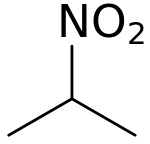2-Nitropropane
 | |
| Names | |
|---|---|
| IUPAC name
2-Nitropropane | |
| Identifiers | |
| Abbreviations | 2-NP |
| 79-46-9 | |
| ChEBI | CHEBI:16037 |
| ChemSpider | 387 |
| EC number | 201-209-1 |
| |
| Jmol-3D images | Image |
| PubChem | 398 |
| |
| Properties | |
| Molecular formula |
C3H7NO2 |
| Molar mass | 89.09 g·mol−1 |
| Appearance | Colorless liquid[1] |
| Odor | Pleasant, fruity[2] |
| Density | 0.9821 g/cm3 |
| Melting point | −91.3 °C (−132.3 °F; 181.8 K) |
| Boiling point | 120.2 °C (248.4 °F; 393.3 K) |
| 17 g/L[1] | |
| Solubility | soluble in chloroform |
| log P | 0.93 |
| Acidity (pKa) | 7.68 |
| Refractive index (nD) |
1.3944 (20 °C) |
| Viscosity | 0.721 cP |
| Hazards | |
| NFPA 704 | |
| Flash point | 24 °C (75 °F; 297 K) (open cup) 39 °C (closed cup) |
| 428 °C (802 °F; 701 K) | |
| LD50 (Median lethal dose) |
720 mg/kg |
| US health exposure limits (NIOSH): | |
| PEL (Permissible) |
TWA 25 ppm (90 mg/m3)[3] |
| Except where noted otherwise, data is given for materials in their standard state (at 25 °C (77 °F), 100 kPa) | |
| Infobox references | |
2-Nitropropane (2-NP) is a solvent. It is a colorless liquid and is classified as a nitro compound.
Preparation
2-NP is produced by the high-temperature vapor-phase nitration of propane, usually with impurities of 1-nitropropane.
Uses
2-NP is used primarily as a solvent and chemical intermediate. It is used in inks, paints, adhesives, varnishes, polymers, resins, fuel, and coatings.[4]
2-NP is also used as a feedstock for other industrial chemicals.[4]
2-NP has uses in the synthesis of phentermine, chlorphentermine, as well as in the synthesis of Teclozan, etc.
Safety
Based on studies in animals, 2-NP is reasonably anticipated to be a human carcinogen[4] and it is listed as an IARC Group 2B carcinogen.[5]
References
- ↑ 1.0 1.1 Record in the GESTIS Substance Database of the IFA
- ↑ CDC - NIOSH Pocket Guide to Chemical Hazards
- ↑ "NIOSH Pocket Guide to Chemical Hazards #0460". National Institute for Occupational Safety and Health (NIOSH).
- ↑ 4.0 4.1 4.2 "Report on Carcinogens" (PDF) (Twelfth Edition ed.). National Toxicology Program, Department of Health and Human Services. 2011.
- ↑ Agents Classified by the IARC Monographs
